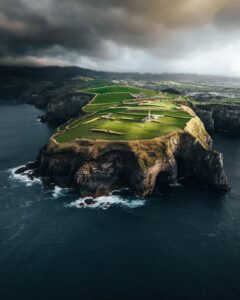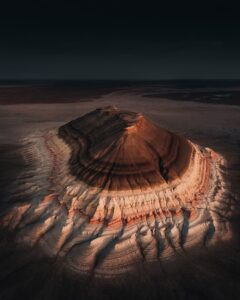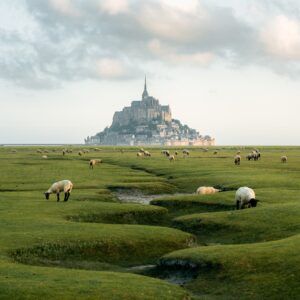
Photo tour in Azores, Portugal
Join us in the Azores for a unique photo tour, where you’ll elevate your creative skills with expert guidance from Ronald Soethje, Bruno Ázera, and Nomadict.
Pawel is a filmmaker who discovered his love for still photography on a trip to Norway in 2007. In the article, he shares some of the lessons he has learned through his travels, including the importance of managing expectations, being kind to people, and not getting too obsessed with taking photos. He also talks about his recent trip to Iceland, where he managed to get an iconic photo of the Skogafoss waterfall that won the best of the week at Nomadict.
As a filmmaker, I was always drawn to the power of moving visuals to tell a story. On my first photography trip to Norway with my friends in 2007, I realized that still photography could capture individual moments and stories in a way that video couldn’t.
I fell in love with the idea of using my camera to freeze a moment in time and tell a story with each shot. I discovered that photography allowed me to be more spontaneous and flexible in my travels, to move at my own pace and capture the perfect lighting and views that I wanted. I quickly realized that the kind of travel that suited me best was one where I could drive from one spot to another, stopping wherever I wanted and seeing as many places as possible in a short amount of time. I loved the rush of discovering new landscapes and the challenge of finding the perfect shot in each place.
For me, it’s not so much about specific moments or experiences, but rather the overall feeling of exploration and discovery that travel and photography bring. One of the biggest impacts on my pursuit of travel and photography was realizing that you don’t need a lot of money to travel and have amazing experiences. By being open to sleeping in a tent or a small car and connecting with other people, you can have incredible adventures and meet fascinating individuals with unique stories.
Every trip is a learning experience, and I’m curious about pushing myself out of my comfort zone and finding out new things about myself and my limits. Sometimes the trip is tough – the trail is long and tiring, or the weather conditions are terrible – but it’s in those moments that I learn the most about myself and my ability to manage my emotions. It’s like a love-hate relationship. These emotions are very vivid on that type of traveling, and it’s exactly emotions that make great photographs!
It’s a great feeling when you come back from a trip and have so many unique souvenirs from it – so unique that no one else’s having them. Editing these photos brings back the excitement of the trip and allows me to experience it again in a different way.
However, one of the most crucial lessons I’ve learned (the hard way) is that the travel itself, the process, and the people around me should always be the priority if it is a personal trip. Once my girlfriend and I went to the USA; visiting the States was my dream since I can remember. We were there for five weeks and I focused on capturing as many moments and places as I could just to take full advantage of the opportunity. The conditions were perfect, sunsets were beautiful, sunrises even more. I’ve tried so hard that sometimes it felt more like work instead of vacation. Guess what? I forgot to enjoy the trip itself. I was on my dream holiday with the person of my dreams in the country I had dreamed of visiting since always – and I was hardly living my dream, being too concentrated on my photography goals. After three weeks I transferred the footage onto my SSD drive and formatted SD cards. When I got back to Poland I was so jetlagged that by mistake transferred all the rest of the footage to that SSD instead of the external HDD, took my SSD drive for a film job, and deleted everything from the first three weeks of my USA trip. It was a painful reminder that I shouldn’t get too obsessed with taking photos and always include moments to reflect on how I am spending my days and if it is really how I want it to be.
Some other things I’ve come to realize are how important it is to manage your expectations and to be kind to people. When I say be kind to people, I also mean to be open to other perspectives, suggestions, and ways of doing things. It’s not always easy but it’s very rewarding. It can make a tremendous difference in your travel experience, in the learning you take away from the trip and the people, and who knows, in future trips and jobs! Nevertheless, I also would like to mention that all the while getting to know people, it is essential to be careful and trust your instincts.
With managing expectations, I refer to the beautiful photos on social media. They often seem so perfect. It can create unrealistic expectations about how a place should look or feel. Keep in mind that reality is often different and places that you visit might not be as exciting. Having low expectations is a very hard skill to learn. I always struggle with it but it definitely helps and allows me to feel more happy and satisfied overall. Visiting Iceland was a good practice for me in this regard. Even though it was almost impossible to keep expectations low because of all I had seen and heard, I didn’t get disappointed!
I was stoked to finally make it to Iceland earlier in 2023, after having to cancel my previously planned trip due to the pandemic. Our main goal was to check out the ice caves, but we also wanted to see other places if conditions would allow.
One of those was of course Skogafoss waterfall. It’s a pretty well-known spot and I’ve seen many pictures before, so I felt like I knew it before I even got there. But actually, being there was a different experience altogether. It was a bit crowded, but since we barely managed to get there before the sunset people were already leaving. I brought along a yellow jacket just for the photo, to take one of those iconic Iceland photos with someone wearing a bright yellow jacket. My friend Bartek graciously agreed to be our model and we got the shot we were after, even if he did end up soaking wet after just a few minutes. The photograph won the best of the week at Nomadict so it was worth it (and I hope also for my friend).

It may seem like it was a very well-thought-out composition, but in my case, most of the time it’s just a spontaneous improvisation that worked out well while being in a rush. When I’m on the spot, with good conditions trying to capture a moment, my brain often goes crazy with all sorts of thoughts like “Where do I even start?” and “Omg, what am I doing?” or “There are too many options!” So, I just try those options one by one, testing different angles, perspectives, and techniques until something feels good and works out nicely. Of course, I also try to remember a few tips and tricks like finding a good foreground, playing with reflections, showcasing the scale of nature to make the shot stand out, separating the subject from the background, etc. If I manage to remember at least two of those things in the midst of all the chaos, then I know I might have a pretty decent shot!
When it came to editing the photo, I wanted to create a darker overall feel and have two dominant colors – yellow and blue. The choice of yellow was pretty obvious since it was the color of the jacket. I tried to match the color of the grass to the jacket, but I still wanted it to look natural. Since it was winter, the grass and ground were already in brown and muddy tones, so I worked with that. To draw the viewer’s eye towards the subject and the reflection in the puddles, I darkened the foreground slightly. While taking the photo I positioned the subject in front of the waterfall to emphasize our smallness compared to the grandeur and power of nature so I wanted it to be pronounced and eye-catching. I also erased other people and minor distractions to keep the photo clean and focused on the subject. It was all about creating a balance between the dominant colors, the subject, and the environment. Removing any distractions, such as people and rocks, was part of creating that balance. I wanted to keep the photo clean and minimalistic. The last and final touch that added a lot of flavor and magic was using color grading wheels to make the tones even more pronounced, clean, and organic.
I’m always reminded that less is more whenever I’m editing photos. I used to think that more colors would make the photo more eye-catching, but I’ve come to realize that sometimes it’s better to keep things simple. For instance, I could capture a breathtaking sunset with tons of colors, but it may end up looking better when I tone down some of the hues and keep my palette minimal. This is just my personal preference, at the end of the day, it’s all about what speaks to you and what makes you satisfied!
In general, the aspects I believe make a great landscape photograph would be:
(1) Lighting. It is not necessary to have beautiful sunbeams coming through the clouds on misty sunrise. Interesting and dynamic lighting can come from all sorts of sources. The right lighting can make an ordinary scene look extraordinary, drawing your eye to the subject, supporting the story or sometimes even telling a story.
(2) Editing. Editing for me is very important. I don’t mind heavy editing, but I believe the final image should be believable, even if it’s dreamy or surreal. When I was younger, every place I visited felt like it was straight out of a fairytale. My imagination was in overdrive, and nature seemed like a separate chapter from a fantasy tale – more vibrant and colorful than anything I’d seen before. That’s what I want to capture in my editing; the same sense of wonder and magic that I felt when I first discovered the beauty of the world around me. Editing can transform a good photo into a great one, and it allows us to convey emotions and tell stories through our images. However, it’s important not to overdo it and lose the authenticity of the moment. The key is finding a balance between enhancing the image and preserving the integrity of the original scene.
(3) Gear almighty. While it’s not the most crucial aspect, having the right gear can help inspire you to shoot new things and take your photography to the next level. That being said, I think that you don’t need the latest and greatest gear to capture a great landscape photo. Just use what you have and focus on honing your skills. When it starts to truly limit you: upgrade!
(4) Lastly, and perhaps most importantly, remember to be responsible when visiting nature. Leave the place at least as clean as you found it and always try to leave no trace. Please do.
(5) A good cup of coffee also helps! 🙂
All the while filming and photographing, in 10 years I’d like to see myself traveling the world as much as possible. I want to explore new cultures and visit places I’ve never been before. I’m especially excited about the idea of building my own van with my girlfriend and taking some epic road trips. Who knows, maybe we’ll even be able to build a cheap electric van by then!
At the same time, I’m working on convincing myself that editing and posting photos is worth the effort. I tend to overthink things and worry about what could go wrong, so I’m trying to remind myself that it’s important to try new things and to not be too hard on myself if things don’t go perfectly. The main thing is to have fun and enjoy the process!

Join us in the Azores for a unique photo tour, where you’ll elevate your creative skills with expert guidance from Ronald Soethje, Bruno Ázera, and Nomadict.

In this article, Forest shares how years of chasing scale, silence, and raw landscapes shaped his approach to photography, from the deserts of Kazakhstan to the volcanic ridges of Iceland. He talks about how he uses light, texture, and vast negative space to create images that feel both intimate and overwhelming.

Simon shares the journey behind his photography, from early inspirations to field techniques, editing, and the story of the winning shot that shaped his path.

In this article, Miro shares how his love for cinematic music evolved into a deep passion for photography and how he uses light, color, and atmosphere to turn the streets of Prague into living film scenes.

In this article, Stefanie reveals how her background in physics sparked her passion for astrophotography and how she blends science with creativity to capture the beauty of the night sky. Readers will discover her approach to color, contrast, and editing, as well as her aurora photography workflow.

Spanish photographer Yhabril captures the profound connection between humans and the mountains that shaped him. Growing up in the Pyrenees, his work bridges outdoor sports, landscapes, and celestial scenes — often blending athletes, moonlight, and wilderness into striking visual stories.

In this article, Ariane shares how photography helped her navigate personal challenges, connect authentically with people and animals, and develop a philosophy rooted in empathy and artistic freedom. Readers will also discover her ethical approach to wildlife photography and her trusted equipment for both camouflage techniques and cameras.

Discover how to photograph Dutch tulip fields in their most magical light. From choosing the right gear and lenses to mastering composition, color, and aerial perspectives, this guide shares creative techniques to capture the beauty of the Netherlands’ tulips. Learn how light, color grading, and proportion bring emotion into every frame.
